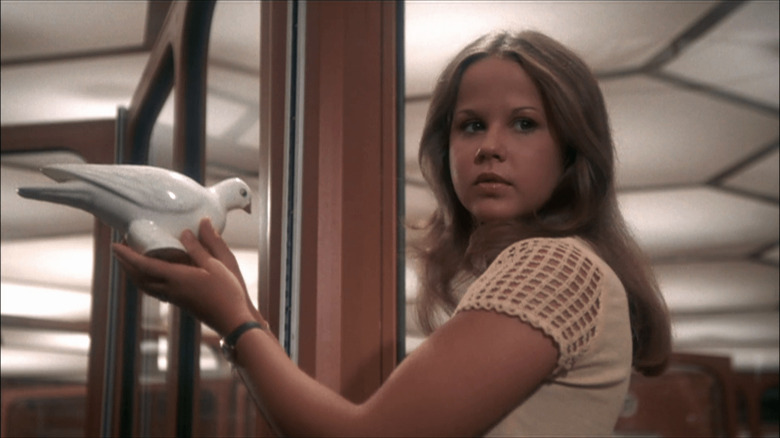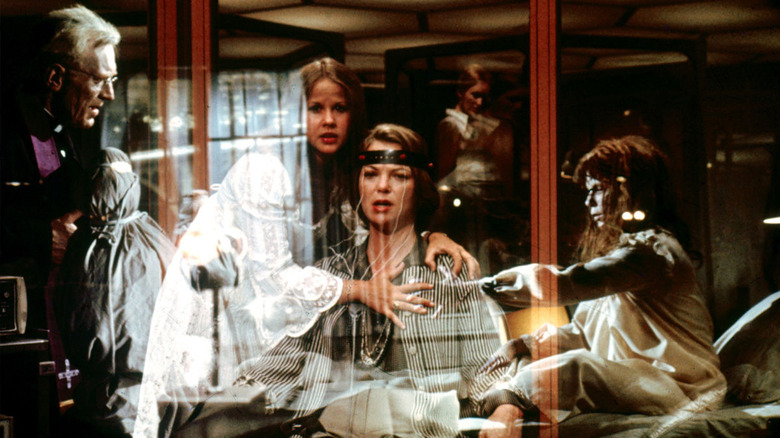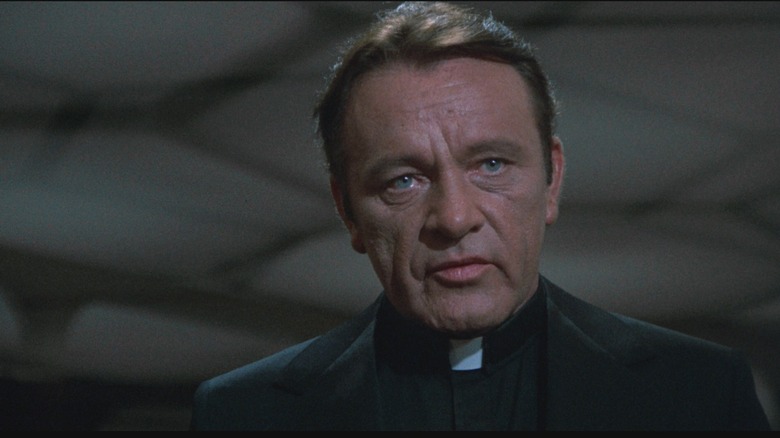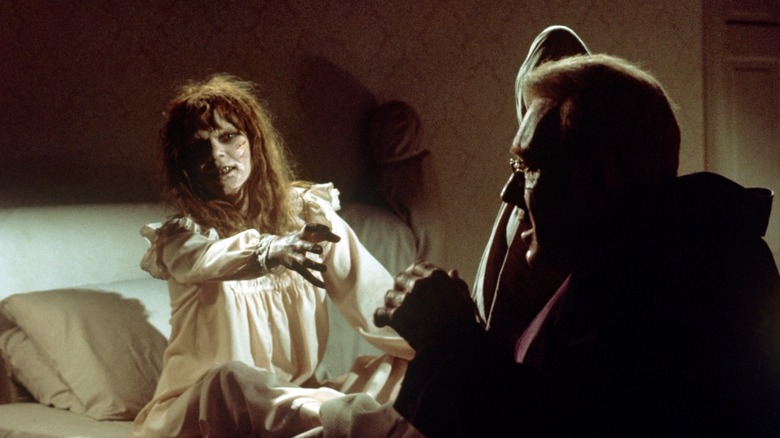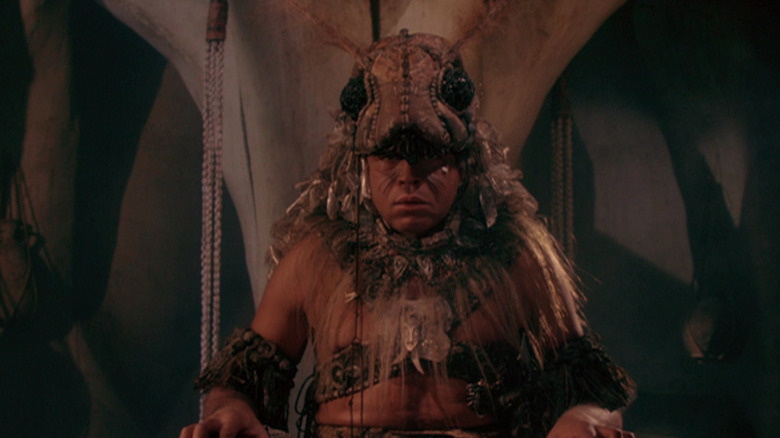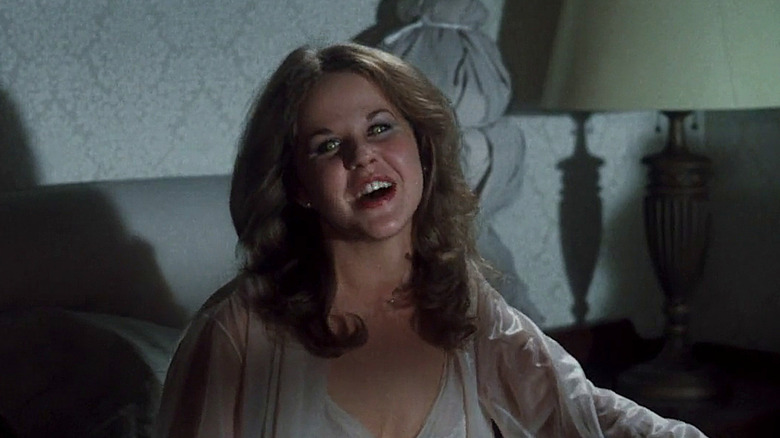Exorcist II: The Heretic Ending Explained: It's All About Locusts
Audience reactions to "The Exorcist" when it was first released have since passed into cinematic lore, with tales of people passing out and vomiting with fear. When it came to the sequel, "Exorcist II: The Heretic," the crowd's reaction was no less visceral, albeit for very different reasons. According to William Friedkin, people in the theater were so incensed by what they saw that they angrily chased the producers down the street (this should probably be taken with a grain of salt).
To say John Boorman's "Exorcist II" has developed a bad rap is a major understatement. In "The Golden Turkey Awards," a readers' poll of the worst films ever made, it placed second only to Ed Wood's B-movie masterpiece "Plan 9 From Outer Space." This offers an interesting point of comparison as both films are the work of an auteur (yes, Wood was an auteur, just a very bad one) swinging for the fences despite their limitations: Wood battled against a lack of budget and talent, while Boorman was making a sequel to a massive box office success that he found "repulsive" in the first place.
There is plenty to dunk on in "Exorcist II" if that's your thing and I can see why so many people do. Visually, it comes as a shock after Friedkin's quasi-documentary approach, and it's hard to think of another sequel as wildly different from the original in terms of theme and style. It must go down as one of the most bizarre major pictures ever to come out of Hollywood, a heady metaphysical mess let down by garbled screenwriting and a stricken central performance by Richard Burton, looking like he's struggling with self-doubt and demons totally unrelated to the plot. If you've seen it, one of the most burning questions is probably, "What the hell was that all about?" Let's tunnel through its distracting eccentricities to find out.
So what happens in Exorcist II again?
"Exorcist II" opens in Rio de Janeiro where Catholic priest Philip Lamont (Richard Burton) is in town to perform an exorcism on a healer who has been possessed by an evil spirit. It all goes wrong when she sets herself alight and dies in the blaze.
Despite proclaiming a lack of faith, Lamont is given another important gig by the Cardinal (Paul Henreid). Factions within the church are seeking to discredit the writings of Father Merrin (Max von Sydow) and posthumously bring him up on charges of heresy, so Lamont is tasked with investigating his death during the exorcism of Regan MacNeil (Linda Blair) four years earlier.
We pick up with Regan in New York where she now lives in a plush Manhattan penthouse with her housekeeper Sharon Spencer (Kitty Winn). She seems pretty well-adjusted and happy, claiming she has no knowledge of what happened to her in Washington during the first film. To keep her actor mom happy (away on location shoot, as Ellen Burstyn refused to reprise her role) she attends sessions with child therapist Dr. Gene Tuskin (Louise Fletcher).
There is little to suggest anything is wrong with Regan until Tuskin starts poking around inside her head in the belief that she has dangerously suppressed memories of her possession. Lamont also arrives at the institute asking questions and, with the help of Tuskin's revolutionary "Synchronizer" device, they go on a brain-synching trip into the girl's psyche to see what happened to Father Merrin just prior to his death. Lamont is suddenly enthused, claiming the machine proves the existence of the demon still residing in Regan. While the doctor and priest are both well-meaning, their meddling is about to unleash psychic mayhem. And locusts. Lots of locusts.
What is all this Synchronizer stuff about?
While "The Exorcist" pitched us into the middle of a turf war between good and evil, John Boorman's sequel is more interested in the metaphysical realm and the convergence of religion and science, represented by Father Lamont and Dr. Tuskin. This is where another of author William Peter Blatty's original inspirations for Father Merrin comes in: Jesuit priest Pierre Teilhard du Chardin. Like Merrin, Teilhard was a globetrotting paleontologist whose controversial theories about evolution landed him in hot water with the church for going against the doctrine of Original Sin.
Teilhard's idea of evolution was that all matter is working its way back to its creator through the process of entropy. Once living organisms reach the point where they become intelligent, they create a "cognitive layer of existence." As evolution continues, so does the development of this "noosphere," building toward a final stage called the Omega Point. This is when mankind is no longer dependent on the physical being and becomes a metaphysical entity capable of surviving the eventual death of the universe. While Teilhard's theories were an optimistic melding of religion and science, the church tried to silence him, forcing him into exile and even making him sign a document recognizing the Adam and Eve story (via New York Times).
Father Lamont refers to Teilhard when Regan asks him if priests believe in ESP (Extrasensory Perception), talking about "mental telepathy" and a "world mind." He goes on to say Father Merrin believed it could happen "quite soon" with scientific research like Dr. Tuskin's; this hive-mind future is hinted at by the honeycomb design of her institute. The danger is that if mankind reaches this point while led astray by Satan, we will become a destructive force rather than a positive one.
Father Merrin in Africa
Dr. Tuskin's trip into Regan's mind awakens the demon Pazuzu, who tries to walk her off a rooftop in her sleep. Luckily, she's saved by some doves in a moment of none-too-subtle symbolism; the birds represent good versus Pazuzu's swarms of locusts throughout the film. Regan dreams of Father Merrin during his time in Africa when, as we learned in "The Exorcist," he once conducted an exorcism that almost cost his life. He was on the continent studying holy men and became fascinated by a boy called Kokumo (Joey Green) who tackled a plague of locusts with a bull-roarer, an ancient musical instrument used to ward off evil.
Lamont synchs up with Regan to find out more. She asks him to call her by her "dream name," Pazuzu, revealing that the demon still holds some power over her. In the vision, Lamont sees that Kokumo was overcome by the swarm, allowing Pazuzu to possess him. Father Merrin took the boy on a perilous ascent to a rock church to perform an exorcism, assailed by the demon's ill winds.
Regan/Pazuzu then takes Lamont on an astral journey to a mud city where grown-up Kokumo (James Earl Jones) now lives; the vision is interrupted when he scares off the demon with a powerful leopard roar. It seems that Pazuzu targets healers like the girl in Rio, Kokumo, and now Regan, all of whom Father Merrin believed are a new stage of evolution emerging in the world. Regan demonstrates her power as a healer by foretelling a fire at the institute and helping an autistic girl speak for the first time. All this convinces Lamont that Pazuzu must be defeated more than ever because he's preventing her from "reaching full spiritual power."
Kokumo
Defying the Cardinal's orders, Father Lamont travels to Africa to seek out Kokumo in the hope he can teach him how to defeat Pazuzu. After a visit to the Rock Church where Father Merrin exorcised the boy many years before, he heads to Jepti, a "mud city with golden walls," based on the Great Mosque of Djenné in Mali. Still unable to find Kokumo, he calls out psychically to Regan again by her dream name Pazuzu, who shows him where the healer is through another vision. Entering a cavern, Lamont finds Kokumo dressed as a locust, who tells him he must pluck out Regan's "evil heart." There is a snag; Lamont has already been tainted by Pazuzu because he has called upon the demon for help and lost his faith in God. Kokumo then gives the priest a spiritual test involving a barefoot walk across some nasty-looking spikes, providing the movie's only moment of gore.
Passing the test, Lamont awakens to find Kokumo as a smart-looking doctor who studies locust behavior. He tells Lamont that the big problem with locusts comes during rainfall when they multiply and crowd together, causing their wings to brush against others. The tactile sensation stimulates the bugs, turning them from "happy-go-lucky" individuals into a destructive swarm with a single mind, "evil breeding evil by contact." This is where the film's apocalyptic theme takes shape; if mankind moves toward the "world mind" with scientific devices like Dr. Tuskin's Synchronizer while under the influence of Satan, we will turn into a voracious horde like the locusts. There is some good news, however. Science is helping evolve the insects towards a "good locust" that can resist the brushing of the wings and break the chain reaction leading to the dreaded swarms.
Regan is the hero in Exorcist II
As much as I love "The Exorcist," I find it a little troubling how the body of a pubescent girl is used as a battleground for good and evil and gets horribly defiled in the process. Regan has far more agency in "Exorcist II," although Linda Blair's limitations as an actor are even more pronounced. Somewhat retrofitting the original, John Boorman's film makes her a saintly figure with newfound psychic abilities as Father Lamont and Dr. Tuskin's well-intentioned but misguided actions open up a gap for Pazuzu to exploit.
Returning from Africa, Lamont is in a trance-like state, indicating that his contact with Pazuzu via Regan exerts a malign influence over him. They head to Washington for a final showdown with the demon in her old bedroom where she was possessed before. Pazuzu tempts Lamont by manifesting as a succubus, ickily portrayed as a seductive demonic clone of Regan. Meanwhile, a plague of locusts descends on the capital as Dr. Tuskin and Sharon also head over to the house, but the latter prevents Tuskin from entering by setting herself alight. It turns out that she has become an acolyte of the Devil in the presence of Regan and the demon within her.
Pazuzu goads Lamont into attacking Regan, who speaks in Kokumo's voice to remind him of the "good locust." This makes Lamont snap out of it and pounce on the demon instead, ripping its heart out as the house collapses around them. Regan escapes outside into the swarm and, channeling young Kokumo, mimics the bull-roarer ritual, subduing the locusts and making them disappear.
Having recovered his faith, Lamont walks away into the night with Regan. He is now ready to continue Merrin's studies and help people like her develop their powers while the Devil is licking his wounds for a while.
